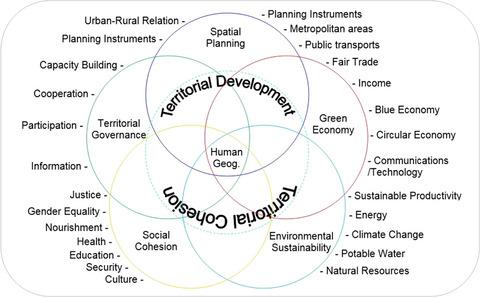Our official English website, www.x-mol.net, welcomes your
feedback! (Note: you will need to create a separate account there.)
The territorial dimension of the United Nations Sustainable Development Goals
Area ( IF 1.6 ) Pub Date : 2020-10-19 , DOI: 10.1111/area.12681 Eduardo Medeiros 1
Area ( IF 1.6 ) Pub Date : 2020-10-19 , DOI: 10.1111/area.12681 Eduardo Medeiros 1
Affiliation

|
This paper explores potential points of intersection and complementarity between several human geography related policy goals and the United Nations Sustainable Development Goals (SDGs). At the same time, it identifies promising directions for delving more deeply into fundamental policy goals associated with spatial planning and territorial cohesion. Inspired by the advantages associated with the holistic and interdisciplinary approach of human geography, the paper proposes two additional SDGs for the 2030 Agenda to reinforce territorial cohesion and planning processes. It concludes that the identification of SDGs is excessively predicated on a prevailing conceptual triad (economy + society + environment). Thereby, it undercuts a common assumption that crucial human geography related policy arenas are not seen as essential pillars of sustainability processes. In particular, the research intends to fuel the clamour for more holistic approaches to sustainable development policies.
中文翻译:

联合国可持续发展目标的地域层面
本文探讨了几个与人文地理学相关的政策目标与联合国可持续发展目标 (SDG) 之间的潜在交叉点和互补点。同时,它确定了更深入地研究与空间规划和领土凝聚力相关的基本政策目标的有希望的方向。受人文地理学整体性和跨学科方法相关优势的启发,本文为 2030 年议程提出了两个额外的可持续发展目标,以加强领土凝聚力和规划过程。它的结论是,SDGs 的确定过度依赖于流行的概念三元组(经济 + 社会 + 环境)。从而,它削弱了一个普遍的假设,即重要的人文地理相关政策领域不被视为可持续性进程的重要支柱。特别是,该研究旨在激起对可持续发展政策采取更全面方法的呼声。
更新日期:2020-10-19
中文翻译:

联合国可持续发展目标的地域层面
本文探讨了几个与人文地理学相关的政策目标与联合国可持续发展目标 (SDG) 之间的潜在交叉点和互补点。同时,它确定了更深入地研究与空间规划和领土凝聚力相关的基本政策目标的有希望的方向。受人文地理学整体性和跨学科方法相关优势的启发,本文为 2030 年议程提出了两个额外的可持续发展目标,以加强领土凝聚力和规划过程。它的结论是,SDGs 的确定过度依赖于流行的概念三元组(经济 + 社会 + 环境)。从而,它削弱了一个普遍的假设,即重要的人文地理相关政策领域不被视为可持续性进程的重要支柱。特别是,该研究旨在激起对可持续发展政策采取更全面方法的呼声。











































 京公网安备 11010802027423号
京公网安备 11010802027423号